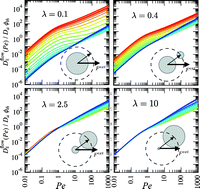The impact of probe size on measurements of diffusion in active microrheology
Abstract
We present a framework to elucidate the influence of polydispersity on flow-induced diffusion in active microrheology. A colloidal probe particle is driven through a suspension of hydrodynamically interacting background particles, where the probe may be larger or smaller than the bath particles. The thermodynamic size of the particles may be greater than their hydrodynamic size; the hydrodynamic sizes can be identical with thermodynamic sizes that differ, or vice versa, or a combination of both. The diffusive behavior is set entirely and dually by the proximity with which two particles can approach one another, and by the extent to which this minimum approach distance is occupied by the hydrodynamic size of the forced particle. We find that reducing the size of the probe reduces flow-induced diffusion when hydrodynamic interactions are weak but increases flow-induced diffusion when hydrodynamic interactions are strong—regardless of the strength of external forcing. This behavior owes its origins to a rich evolution of the dominance of hydrodynamic and entropic forces with changes in the relative hydrodynamic and thermodynamic sizes of the particles.

- This article is part of the themed collection: 2016 Lab on a Chip Emerging Investigators

 Please wait while we load your content...
Please wait while we load your content...